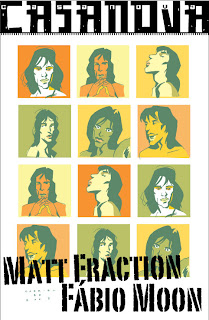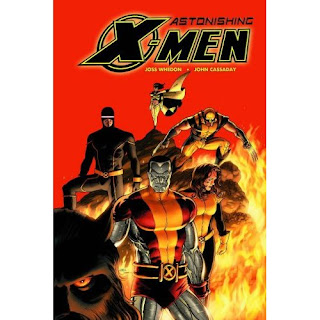
Flavor Flav!

Flavor of Love 3!
Go vote for Dame Darcy today!
What we talk about when we talk about comics.




SUGARSHOCK!
By Joss Whedon & Fábio Moon
With Dave Stewart and Nate Piekos
Published by Dark Horse Comics, August 2007. Free for you, and free for me!

LOUD MUSIC! LOUD MUSIC! STRANGE BUZZING!! “I’m not saying that I’m better than you…. I’m not saying I’m rubber and in no way did I suggest you’re glue” goes the future pop-hit from SUGARSHOCK! a four-piece band hailing from another beyond I would not mind visiting. Joss Whedon is taking off to more otherworldly outfits to get his brand of girl power on and I couldn’t squeal louder. SUGARSHOCK! is his own tweaked take on Jem and the Holograms or Josie and the Pussycats and has genre-mashed its way into my heart. One thing I have come to know about Joss is his passion for music, whether it is Sondheim or slow jams. Born from this love of hard-rockin’ tunes, SUGARSHOCK! is poised to be a release for all the creative energy stifled from the cancellation of Firefly, as this online-only web comic draws the closest, of his recent work, to representing the energy and the wit of the tragically befallen series.
Dandelion, the lead singer of the band, is a precocious and slightly schizophrenic Viking- hater. Her drummer, Wade, is a voluptuous woman of such awesomeness she brings home a groupie from every concert for indiscreet sex and absolutely no talking. L’Lihdra, lead guitarist, looks masculine in her pinstriped suit but has ways of resolving the in fighting with a sensitive touch. Then there is Robot Phil, the robot bassist, who is a robot, and he likes to ride shotgun and not to be threatened. I love these characters in a way I have not loved a group of people since the crew of Serenity. Their personalities are so distinct, and every word that comes out of their mouths are facets of who they are, marvelously specific. The language is a shade too precise, and all of the background details are awkwardly, and hilariously, straightforward. (The winner of the South Fairville Hormer’s Shrimp n Taco Rock Off receives a giant check with BIG CHECK written on it. Hee.)
The gorgeous artwork makes this my favorite single issue to come along based on the art alone. Fábio Moon has a way of making everything loose and flowing with electricity. Whimsical details like Dandelion’s stink-eye projecting a small lightning bolt are funzies. I took a special shine to a cloud of hearts obstructing the view, of which I won’t say anything more. Whedon’s mission is to make us fall in love with yet another amazing ensemble, and SUGARSHOCK! is an unqualified success. All I want is to read more, get to know the group better, and see what’s going to happen next. This is 8 pages of pure joy, man, go read it!

Madame Mirage: First Look
By Paul Dini & Kenneth Rocafort
Colors by (pgs 4-7) Blond, Letters by Troy Peteri
Published by Top Cow, May 2007. $0.99

Paul Dini is partially responsible for my geek awakening, as I was a serious addict of Batman: The Animated Series. His work on Lost is excellent, and I enjoy his Eisner winning one-shot Mad Love. He is a writer I respect, but Madame Mirage made me feel excluded.
The first thing, well first two things, that struck me are the size of Madame’s breasts. I understand Top Cow has a reputation for having large bosomed women in their comics, but I believe it cheapens the title. I feel this choice is particularly off mark considering Madame’s power. She has the ability to appear as anything she wants; like a mirage, one might say. Therefore, unless there is a character driven reason why an action heroine would desire huge breasts I’m not going for it. Besides, the big failing of the story is we never witness a demonstration of her Mystique-like powers to solve the conflict. Instead, she blows her prey out of the sky with a large pistol. I could not discern a single moment to invite the reader to understand what she is about. Dini’s two-page introduction detailing how Madame Mirage began as an internet cartoon and became a comic series is interesting, but the material for this ongoing series does not grip me.
When I read Dini’s introduction, I thought the pulpy mixture of sci-fi super heroics and noir crime drama sounded intriguing. Of interest is Dini’s goal to explore unusual super powered villains, and I do see promise in a heroine who can appear as anything. It is particularly intense because most everyone depicted has armor or gear of some kind in assisting their power, it seems, but Mirage tramps around in a white high slit slinky number and a wide brimmed hat. I wonder how it is she can allow herself to be vulnerable. I wonder if she can even be vulnerable at all. I’ll admit I am curious to discover why she has investment in fighting crime syndicates, and where her interests align.



Ultimate Spiderman #111
By Brian Michael Bendis, Mark Bagley, and Stuart Immonen
Colors by Justin Ponsor, Letters by VC’s Cory Petit
Published by Marvel Comics, July 2007. $2.99


After two game-changing action-packed arcs - The Clone Saga and Ultimate Knights - Brian Michael Bendis has grabbed our shaken, frail bodies and forced us to sit with him and have a quiet chat. Between fighting various mutated freaks, dealing with the Ultimate love triangle, going to school and working at the Daily Bugle, Peter has had no time to deal with his disapproving Aunt May who once figured so closely to his daily life.
Aunt May’s guilt over Uncle Ben’s death became known in an issue similar to #111, "The Talk", the appropriately titled “Guilt,” issue #45. In “Guilt,” Aunt May talks to her psychiatrist about her inability to cope with a world where vigilantes run around in their pajamas doing whatever they want. She is relieved at the assurance her nephew is not involved in this fast growing trend. Issue #111 brings her growing concerns full circle. May has come to know the ugly truth: Peter Parker IS Spiderman. Yes, it’s time for that talk. I enjoyed reading Peter’s rationalization of the Spidey-sense, and Aunt May knowing the full story of the day the infamous radioactive spider bit Peter. In an odd, subtle moment, he tosses off the once traumatizing incident when Green Goblin threw Mary Jane off
The one disappointment with this issue is a flashback to a battle with Ultimate Spot at the ROXXON labs just before picking up Aunt May at the hospital. The artist Stuart Immonen, to whom regular artist Mark Bagley is passing the Ultimate torch with #111, illustrates this sequence. The reader has the unfortunate position of only seeing their dialogue along the margin. I am disappointed this dull “staged reading” effect was implemented. While I love the witty exchange with May’s comical inability to understand what Peter is saying, and that the trashed lab hurt Peter’s young scientist heart, I would have expected a more ambitious execution of the conversation. Interspersing the intimate kitchen chat with the fight would have proved more engaging, especially if Bagley’s softer style had been integrated with Immonen's contrasting angular take on action sequences. This section felt like there was a last minute decision to include Immonen on the story; as a result, it felt lazy.




